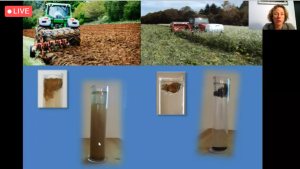A Policy Dialogue – Can Glyphosate play a role in achieving greater Biodiversity?
An online policy dialogue organized by EURACTIV and supported by the GRG took place on 4 November 2021. The event brought together a panel of experienced professionals to discuss how biodiversity was addressed in the Scientific Report on the Assessment of the Renewal, glyphosate’s role in agricultural practices, and whether and how it can contribute to greater biodiversity.
The panellists, which included two scientists and a GRG representative, discussed glyphosate’s role in conservation agriculture and the importance of protecting the soil and maintaining its structure to preserve biodiversity.
In addition to the panellists, a French farmer also contributed to the discussion by recording a video message, focusing on the use of conservation agriculture and glyphosate she has been doing on her farm.
Dr. Jana Epperlein, Soil Scientist and Agricultural Engineer at the Society for Conservation Tillage (GKB eV) underlined the importance of turning to nature-based solutions in agriculture, such as conservation agriculture. She stressed that no-tillage farming guarantees the protection of the soil structure, which is fundamental to creating the best environment for plants and animals.
She finally stated that on farms where a no-tillage system is used, farmers need herbicides to protect the crops and that, according to her, would prove very difficult to do without glyphosate.
Dr. Simon Jeffery, a soil microbial ecologist and currently a Reader in Soil Ecology at Harper Adams University in the UK, stressed how soil is often an undervalued resource. According to Dr. Jeffry, soil contains a concentration and a variety of biodiversity that cannot be found anywhere else.
He focused on the need to move towards conservation agriculture practices as a tool to avoid issues related to food security and climate change. In his view, glyphosate is a key tool in the farmer’s toolbox of conservation agriculture.
He explained that when the soil is ploughed, organisms that live in it and preserve its structure are killed; this leads to soil disruption and the loss of nutrients and biodiversity.
Speaking of carbon sequestration, Dr. Jeffery explained that if farmers stopped tilling, we could sequester many more tonnes of carbon in the following years, contributing to the fight against climate change.
Dr. Virginie Ducrot, the Head of Environmental Effects at Bayer, a GRG member, underlined the importance of the scientific evaluation, including understanding glyphosate’s impact on biodiversity.
She emphasised that no risks for humans nor the environment were found in the draft Renewal Assessment Report (dRAR).
She reiterated that the Glyphosate Renewal Group is committed to transparency and that all scientific data and public literature are available through its website. She stressed that research and development are extremely important, and there is a science-driven willingness to advance tools for farmers. However, she also admitted that none of the new chemical solutions currently in the pipeline could efficiently substitute glyphosate. Additionally, the mechanical solutions in development, such as drones, cannot be the solution in the near future.
In her video message Sarah Singla, a French farmer in the South of France shared that she has been using no-tillage practices since the 1980s. She highlighted the role glyphosate has been playing in her farm for the past decades. According to her, glyphosate allows her to protect the soil while steadily increasing the yields at the same time.
She also showed two different examples of soils, which can be seen in the image below or via this link.
On the left is the sample of soil that was collected following tillage, and on the right, soil collected from a field where conservation agriculture is practiced (no ploughing). She demonstrated that not only is the soil healthier, more structured, and more compact on the right, but the biodiversity that develops on and around the field is also much greater.

Please find the event’s recording in this link.